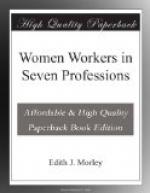In almost all the theatres, even where the conditions are considered above criticism, the lavatories reserved for the ladies are, by a curious arrangement, generally on the floor where most of the actors dress. They are almost invariably difficult to use, for as the dressing-rooms are usually allotted by men, there is little consideration of women’s comfort in this matter. It is a curious side-light on the intelligence of men that they almost universally seem to think that women, by a special Providence, are exempt from these natural laws; and almost all women are still too Early Victorian to insist upon some change. Many of the old theatres in London and the provinces suffer from want of proper ventilation; and many of them are appallingly, incredibly dirty. In the provinces dressing-rooms are sometimes dripping with damp; and it is not an uncommon experience to share the room with mice and other vermin.
It is only possible for me to touch very lightly on employment by the cinematograph firms; but from the enquiries I have made, the usual payment seems to be roughly from 5s. to 7s. 6d. a day, the workers finding their own clothes: 10s. 6d. if the workers can ride and swim: 3s. a day for walking on, when light meals are provided. There is a form of application to be filled in, which demands the following particulars:—
Height.
Bust measurement.
Waist measurement.
Skirt length.
Age.
Line of work.
Remarks.
Ride horseback. Cycle. Swim.
The pictures take about ten days to prepare, and as a supplementary trade, undoubtedly this work is of value to the actress.
An evil which attacks the theatre of the present day is the horrible mantle of respectability which has settled on the profession. Respectability in Art is a blight which undermines, and the moment any worker or profession of workers is accepted on equal terms by the non-workers of the community, misery invariably ensues. It is impossible for a non-worker to comprehend the life of a worker, or to make any margin for the work, which, if we judge by the example of their own lives, they evidently despise. The restrictions which all honest work brings, along with its compensations, are annoying to ornamental parasites; and the contempt for restrictions is apt subtly to undermine the mind of the worker.
There is no doubt that for the average actress, when such an enormous number of people are rushing into the theatrical profession, there is little security. The life of a successful actress is undoubtedly one of the very best, so far, open to women. It is not a fact that the best and greatest actresses are always the successful ones: but it is a truth that all the successful ones have some natural qualifications which have enabled them to gain that position.
Then what is the matter with the theatre? and why has it become such a miserable life for the average worker? It is an unskilled trade, and the people who have control of the trade have a contempt for the average worker. They believe they can teach in a few weeks, what they have not, in years, succeeded in mastering themselves. The unfortunate worker is taught like a parrot, used for a short time, and then thrown on the scrap-heap of the unfit for the theatre, when the theatre has unfitted them for more honourable work.




